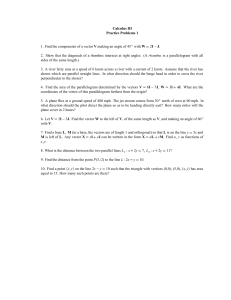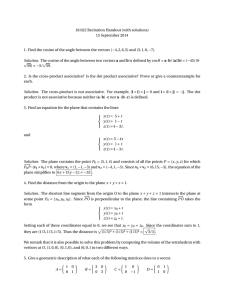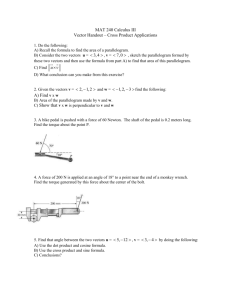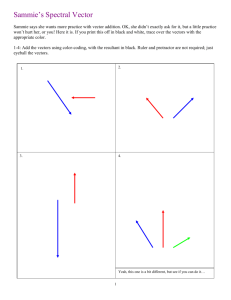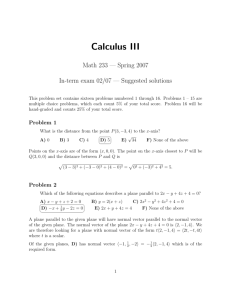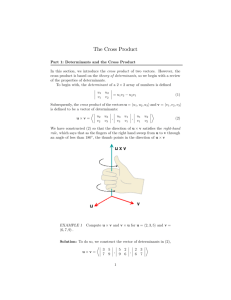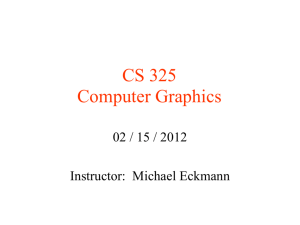Lecture 3: Cross Products, Equations of Planes
advertisement
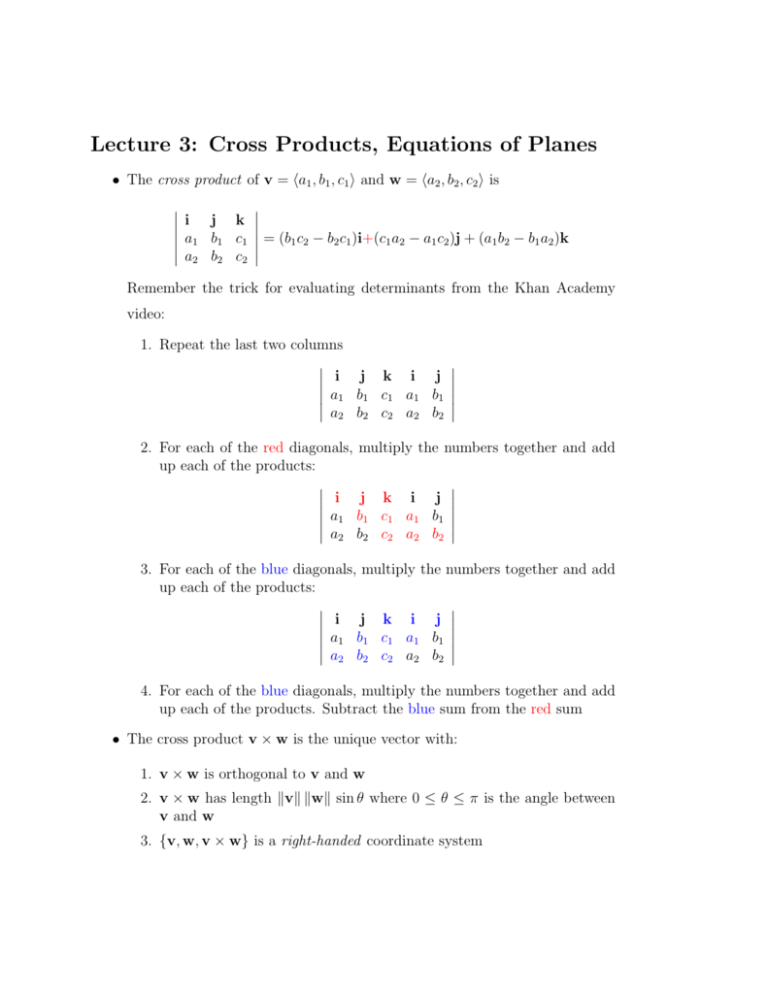
Lecture 3: Cross Products, Equations of Planes
• The cross product of v = ha1 , b1 , c1 i and w = ha2 , b2 , c2 i is
i j k a1 b1 c1 = (b1 c2 − b2 c1 )i+(c1 a2 − a1 c2 )j + (a1 b2 − b1 a2 )k
a2 b 2 c 2 Remember the trick for evaluating determinants from the Khan Academy
video:
1. Repeat the last two columns
i j k i j a1 b1 c1 a1 b1 a2 b 2 c 2 a2 b 2 2. For each of the red diagonals, multiply the numbers together and add
up each of the products:
i j k i j a1 b 1 c 1 a1 b 1 a2 b 2 c 2 a2 b 2 3. For each of the blue diagonals, multiply the numbers together and add
up each of the products:
i j k i j a1 b 1 c 1 a1 b 1 a2 b 2 c 2 a2 b 2 4. For each of the blue diagonals, multiply the numbers together and add
up each of the products. Subtract the blue sum from the red sum
• The cross product v × w is the unique vector with:
1. v × w is orthogonal to v and w
2. v × w has length kvk kwk sin θ where 0 ≤ θ ≤ π is the angle between
v and w
3. {v, w, v × w} is a right-handed coordinate system
Things to Do
1. Find the cross products i × j,
j × k,
k × i. and j × j.
Solution: k, i, j, and 0.
2. Find the cross product of v = h1, 2, 1i and w = h3, 1, 2i
Solution: h3, 1, −5i .
3. Find the two unit vectors orthogonal to h3, 1, 1i and h−1, 2, 1i
Solution: The cross product of these two vectors is h−1, −4, 7i. The corresponding unit vector is √166 h−1, −4, 7i. This unit vector, or the same vector
with opposite sign, will be orthogonal to the given vectors.
4. How are v × w and w × v related?
Solution: v × w = −w × v.
5. What is v × v?
Solution: 0.
Properties of the Cross-Product
• (Antisymmetry) v × w = −w × v
• v × w = 0 if and only if w = λv for some scalar λ, or if v = 0.
• (Scalars “factor out”) (λv) × w = v × (λw) = λ(v × w)
• (Distributive law) u×(v+w) = u×v+u×w and (v+w)×u = v×u+w×u
Geometry of the Cross-Product
• The parallelogram spanned by v and w has area kv × wk
• kv × wk2 = kvk2 kwk2 − (v · w)2
Vector Triple Product
u
u · (v × w) = det v
w
That is, if u = ha1 , b1 , c1 i, v = ha2 , b2 , c2 i, and w = ha3 , b3 , c3 i, then
a1 b 1 c 1 u · (v × w) = det a2 b2 c2 a3 b 3 c 3 The parallelipiped spanned by u, v, and w has volume |u · (v × w)|.
More Things to Do
1. Using i × j = k, j × k = i, k × i = j, compute (i − 3j + 4k) × (i + j − 7k)
2. Find the area of the parallelogram spanned by h1, 0, 3i and h2, 1, 1i.
3. Find the volume of the parallelepiped spanned by u = h2, 2, 1i, v = h1, 0, 3i,
and w = h0, −4, 0i.
4. If v = ha1 , b1 , c1 i and w = ha2 , b2 , c2 i, find kv × wk2 and (v · w)2 .
Review
So far we’ve studied vectors in two- and three-dimensional space, and the following
operations on them:
• Addition of vectors (“parallelogram rule”)
• Scalar multiplication of vectors
• Scalar product v · w (defines orthogonality, projections)
• Cross product v × w (right-hand rule, area of parallelogram)
• Triple product u · (v × w) (volume of parallelepiped)
Equations of Lines and Planes
You can specify a line in three-dimensional space by specifying a point P that
the line passes through and the direction v of the line. If P0 = (x0 , y0 , z + 0) and
v = ha, b, ci then
r(t) = r0 + tv = hx0 + at, y0 + bt, z0 + cti .
You can specify a plane uniquely in three-dimensional space by specifying a
point P0 in that plane and a normal vector n. If P0 = (x0 , y0 , z0 ), n = ha, b, ci,
and P = (x, y, z) is any other point in the plane, then
−−→
P0 P · b = 0
or
x − x0 , y − y0 , z − z0 · ha, b, ci = 0
or
a(x − x0 ) + b(y − y0 ) + c(z − z0 ) = 0
Things to Do
1. Find the equation of the line through the point (1, 2, −4) in the direction
v = h1, 2, −3i. Solution: r(t) = h1, 2, −4i + t h1, 2, −3i.
2. Find the equation of the plane through the three points (1, 0, 0), (3, 0, 0), and
(1, 2, 0). Solution: Call these points P1 , P2 , and P3 respectively. Two vectors
−−→
−−→
in the plane are P1 P2 = h2, 0, 0i and P1 P3 = h0, 2, 0i. The cross product of
these two vectors is n = h0, 0, 4i. If P − (x, y, z) is any other point in the
−−→
plane P1 P = hx − 1, y, zi and the equation of the plane is
−−→
n · P1 P = 0
h0, 0, 4i · hx − 1, y, zi = 0
z=0
We should have known. All of these points line in the xy plane, whose
equation is z = 0!
